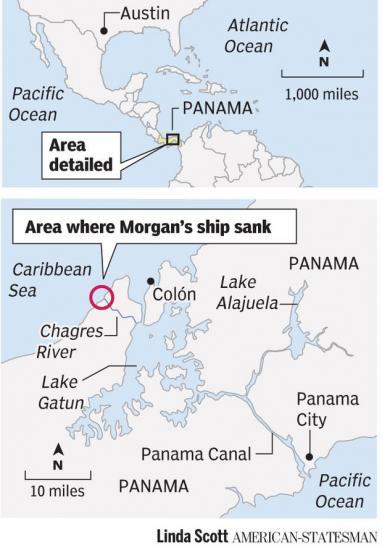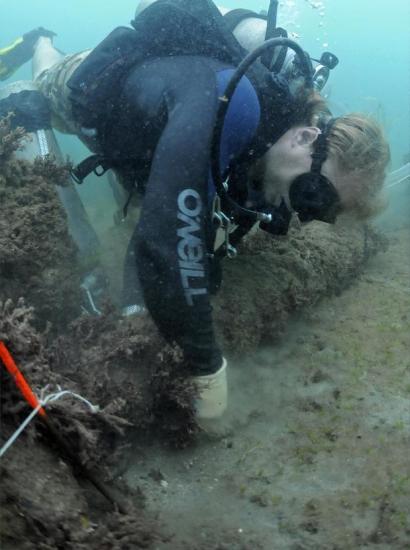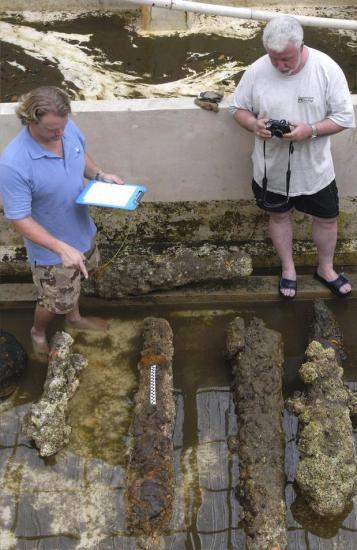Team recovers cannons thought to be Captain Morgan's
Archaeologists searched in Panamanian waters for sunken pirate ship.
Patrick George
Source - http://www.statesman.com/news/local/team-including-texas-state-professor-recovers-cannons-thought-1335660.html
Small Type
In 1671, the English pirate-for-hire Captain Henry Morgan spearheaded a raid on Panama, then the richest city in Spain's colonial empire, leading thousands of men and a naval fleet armed to the teeth.
But while Morgan was a brilliant military strategist, he wasn't much of a navigator, according to Texas State University underwater archaeology professor Frederick Hanselmann. Not long after one of Morgan's advance parties captured a Spanish fortress at the mouth of the Chagres River, Morgan crashed his flagship, the Satisfaction, into a reef, causing it and three or four other ships to sink.

The ships disappeared into the water and were forgotten until last year when Hanselmann and fellow archaeologists unearthed cannons that might have belonged to Morgan's fleet.

Donnie Reid/ASSOCIATED PRESS - Professor Frederick Hanselmann recovers a cannon that might have belonged to Henry Morgan at the mouth of the Chagres River in Panama.
It was the first archaeological study of the area and the first direct evidence of the presence of Morgan or his men.
After the wreck, Morgan continued up the river on foot to lead a devastating and politically controversial raid on what's now Panama City.

Facundo Bacardi - Hanselmann and fellow archaeologist James Delgado look over cannons that the Texas State professor says might have belonged to the Satisfaction, a French ship taken by Captain Henry Morgan. The ship crashed into a reef and sank in Panama's Chagres River.
The guns recovered in September are undergoing restoration in Panama, where they will eventually be displayed in a museum. The team made the announcement of the discovery in late February.
Hanselmann, who joined Texas State in December, said the discovery is significant because it sheds light on an exciting time in human history, one that has captured people's imaginations in books and movies — such as Disney's "Pirates of the Caribbean" — but isn't well-documented archaeologically.
"Archaeology is all about our shared past," said Hanselmann, the chief underwater archaeologist and dive training officer with the River Systems Institute and the Center for Archaeological Studies . "This is a global story."
Scourge of the seas
Morgan was born in 1635 and was most active as a seafaring raider in the 1660s and early 1670s, Hanselmann said. He was employed as a privateer — a private citizen given wartime authorization by a nation to attack enemy ports and fleets. Hanselmann said such arrangements were less expensive for England than building a military armada like Spain's.
Morgan's exploits were some of the most lucrative.
"Morgan had a commission from the English to sack and raid enemies of the state," Hanselmann said, adding that the captain's tactics infuriated the Spanish government and gave him a substantial following of men on his expeditions.
"Now, one man's privateer is another man's pirate," Hanselmann said. "He was a thief; he was a dog."
Morgan's last great raid was his sacking of Panamá Viejo , now a part of Panama City. At the time, the isthmus separating the Atlantic and Pacific oceans was pivotal for trading silver, gold, gems, furs, sugar and other precious items, and Spain kept other countries out. England, tired of being excluded, sent Morgan there to raid the city.
Although he crashed some of his ships in the Chagres River, he and 1,400 men went on to sack Panamá Viejo on Jan. 28, 1671 .
"He was this really charismatic guy who just didn't quit," Hanselmann said.
Morgan's forces defeated the city's militia, and then they or the Spanish military leaders started a fire that burned the city to the ground.
What Morgan didn't know, because of poor communication methods at the time, is that England and Spain had signed a peace treaty months earlier, Hanselmann said.
Morgan was arrested and charged as a pirate when he returned to England but was given a slap on the wrist. He was later knighted and made lieutenant governor of Jamaica. He retired to a sugar plantation in Jamaica, where he died in 1688 .
Unearthing a legend
Morgan's ships and weapons sat on the bed of the Chagres River undisturbed until 2008, when Hanselmann, along with fellow archaeologists James Delgado, director of maritime heritage for the Office of National Marine Sanctuaries of the National Oceanic and Atmospheric Administration, and Dominique Rissolo, executive director of the Waitt Institute for Discovery , went looking for them.
They surveyed, mapped and documented submerged sites, shipwrecks and other artifacts along the banks of the river.